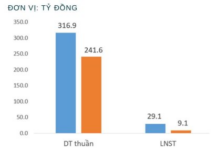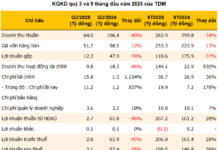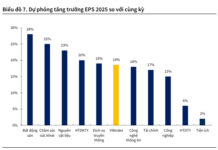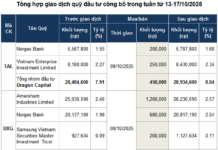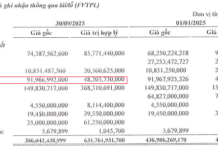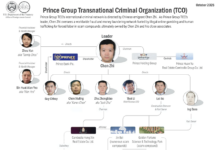On July 5, in Hanoi, the Lao Dong Newspaper coordinated with the Ministry of Construction and the Ministry of Natural Resources and Environment to organize a workshop on “Unblocking Obstacles and Promoting the Real Estate Market Development.”
Based on a review of the legal regulations in the process of implementing the procedures for deploying investment projects in real estate business, as an independent expert, Mr. Pham Thanh Tuan, Master of Science, evaluated the legal “barriers” that businesses face when implementing real estate projects.
According to Lawyer Pham Thanh Tuan, Master of Science, the first difficulty is the lack of synchronization between land use planning and plans and the arrangement of houses and land use plans of equitized enterprises. Accordingly, he proposed amendments and supplements to the legal regulations in the following directions:
First, the Government should consider submitting to the National Assembly amendments to Point (m), Clause 2, Article 2 of Resolution No. 82/2019/QH14 dated June 14, 2019, of the National Assembly, so that the land use of enterprises after equitization complies with the provisions of land law and does not arise conditions for complying with the approved land use plan.
Second, supplement the transitional provision in Decree No. 126/2017/ND-CP amended by Decree No. 140/2020/ND-CP, stating that: “The People’s Committees of the provinces and centrally-run cities shall have the responsibility to review and approve the land use plans of enterprises that have undergone equitization, including cases where there is no longer state capital in the enterprise.”
Third, when promulgating a decree guiding the 2024 Land Law, the Government needs to clarify the case where an enterprise changes the land use purpose in accordance with the approved land use planning and plans of the localities but not in accordance with the approved arrangement of houses and land use plans. How should this be handled?
The second difficulty is the requirement for commercial housing projects to have residential land according to Article 127 of the Land Law. Thus, commercial housing projects without “residential land” must continue to “wait.”
Mr. Tuan cited that, according to the current legal regulations, the selection of investors for commercial housing projects is carried out through one of three methods: (i) land use right auction, (ii) bidding, or (iii) approval of investment policies simultaneously with the approval of investors. Complex issues arise for projects selecting investors through the method of approving investment policies simultaneously with the approval of investors. According to Article 127 of the 2024 Land Law, investors must have a whole or partial “residential land” to be approved as investors without going through auctions or bidding.
Thus, for enterprises that have the right to use land but do not have “residential land,” they will not be approved as investors even if the project complies with urban planning, land use planning and plans, and housing development programs… This approach inadvertently creates barriers for businesses implementing commercial housing projects over the past time. As of early 2022, according to the Ministry of Planning and Investment, many localities are stagnant, with Hanoi having 102 projects, Ho Chi Minh City having 150 projects, and Binh Duong having 40 projects…
In reality, it will be challenging to have commercial housing projects implemented by enterprises that meet the requirements for the area of “residential land” to be transferred, and the detailed planning of the project is often much larger than the area of residential land of households and individuals.
After the 2024 Land Law takes effect, the real estate market is expected to have only commercial housing projects that are investment projects in building urban areas and rural residential projects formed through the State’s land retrieval.
This regulation leads to the fact that production and business projects (for example, tourist areas and production and business areas that have been adjusted by the State in land use planning into residential land and adjusted in urban planning into commercial housing) will not be able to implement the adjusted planning, leading to a waste of state budget in planning and adjustment.
This will hinder the development of the real estate market and fail to fully implement the policy of Resolution No. 18-NQ/TW on “Continuing to implement the mechanism of self-agreement between people and enterprises in transferring land use rights to implement urban projects and commercial housing.”

Mr. Pham Thanh Tuan, Hanoi Bar Association, Real Estate Legal Expert. Photo: To The
Lawyer Tuan continued to propose solutions as follows: The Government should consider completing and submitting to the National Assembly for consideration and approval a resolution on piloting the implementation of commercial housing projects through agreements on the transfer of land use rights or having the right to use land that is not “residential land” to remove difficulties for enterprises that are “stuck” due to the lack of residential land.
The third difficulty is that the establishment of construction planning and detailed urban planning at the 1/500 scale still has many problems. Mr. Tuan said that according to Clause 1, Article 29 of the 2020 Investment Law (amended in 2022), there are three forms of investor selection: (i) auction of land use rights, (ii) bidding for investment projects with land use, and (iii) approval of investment policies simultaneously with the approval of investors.
Also, according to the 2024 Land Law, in the case of selecting investors through the method of auctioning land use rights, the responsibility for formulating detailed planning at the 1/500 scale belongs to the competent authority according to Point c, Clause 2, Article 125 of the 2024 Land Law, which stipulates “having detailed planning at the 1/500 scale formulated and approved by the competent state agency for housing construction projects.”
Similarly, for projects that organize investor selection through bidding, the 2024 Land Law (Point b, Clause 3, Article 126 and Point b, Clause 7, Article 126) stipulates that the provincial People’s Committees “organize the formulation of detailed planning or have a 1/2000 scale subdivision planning.”
Thus, basically, in the case of investment projects implemented through the method of auctioning land use rights or bidding for projects with land use, the responsibility for formulating subdivision planning and detailed planning belongs to the People’s Committees and competent authorities.
However, for projects selecting investors through the method of approving investment policies simultaneously with the approval of investors, one of the requirements for project appraisal to approve investment policies is that the project must be in line with the planning (Point a, Point 3, Clause 33, Investment Law). For housing projects, they must also “be implemented in accordance with the approved detailed planning” (Point a, Clause 1, Article 33, Housing Law 2023). In reality, the appraisal of projects with land use, especially commercial housing projects, requires the localities to have an approved 1/500 scale detailed planning as a basis for evaluation. Thus, without an approved 1/500 scale detailed planning, enterprises will not have a basis and grounds to submit a dossier for approval of investment policies for the project.
Meanwhile, due to limited resources, many areas in localities have only approved general planning or subdivision planning, and many areas do not have detailed planning at the 1/500 scale. Due to the lack of approved detailed planning at the 1/500 scale and the absence of investment projects, enterprises with legitimate land use rights have not been identified as “project investors” and are not subject to the formulation of detailed planning at the 1/500 scale.
Lawyer Pham Thanh Tuan, Master of Science, suggested that to “remove” the above practical difficulties, it is necessary to have regulations allowing enterprises and economic organizations to formulate detailed planning at the 1/500 scale in areas where they have legitimate land funds according to land law regulations (to exclude cases where projects must be bid or auctioned, in which case the responsibility for formulating planning belongs to the state agency). This contributes to unlocking land resources, speeding up the “coverage” of planning, and not creating a situation of group interests.
“For areas that have approved general planning or subdivision planning, enterprises and economic organizations shall be allowed to propose to the provincial People’s Committees for approval to organize the formulation of tasks and detailed planning at the 1/500 scale in cases where they have legitimate land use rights according to land law provisions, and the projects are not subject to the selection of investors through bidding or auction methods, except for cases prescribed by law.”
Astonishingly high price for old and dilapidated apartment buildings reaching nearly 200 million VND/m2, rivaling the most luxurious condominiums in Hanoi
Old collective apartments with prices starting from 100 million VND/m2 are usually the first-floor units that can be used for commercial purposes, while the upper-floor units are priced at 60-80 million VND/m2 for residential purposes.














